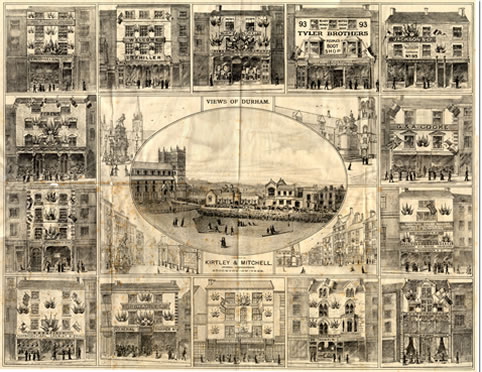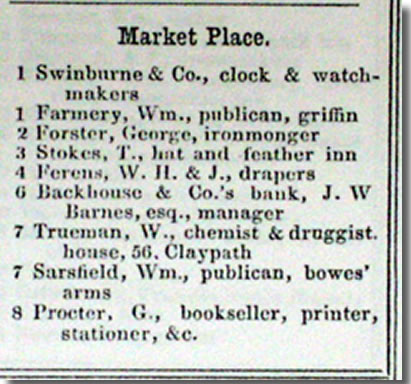
What could you buy there?

Engraving of shops in Durham Market Place decorated for the visit of the Duke of Albany. (DCRO ref: D/X458/2)
Take a close look at this image. It is a picture that was produced in 1884 for a local newspaper and shows how some of the shops in Durham were decorated for a visit by the Duke of Albany.A larger version of the image is available if you can’t see the shops clearly.
Make a list of all the types of shop you can see and then find out what each one sells. You can draw a table like the one below or print one out to fill in.
| Type of shop | What it sells |
|---|---|
| Milliner | Hats |
Remember to think about the big questions… What does this source tell us about what people could buy in Victorian Durham? What does it tell us about how people did their shopping? What is different to today?
There is also another source we can use to find out more about what people could buy in Durham Market Place. Read on to find out about trade directories.


Extract from the 1862 Trade Directory for Durham. (DUL ref: L 910.3 DUR/CIT/DUR)
This source is an extract from a Durham trade directory of 1862. It lists all the people with a shop or business in Durham. This section shows all the people who had businesses in the Market Place.
Take a close look at the source and then fill in this tally chart.
| Bank | |
| Boot and shoemaker | |
| Brickmaker | |
| Butcher | |
| Chemist and druggist | |
| Clockmaker | |
| Draper | |
| Grocer | |
| Hosier | |
| Innkeeper or publican | |
| Painter | |
| Printer or stationer | |
| Saddler | |
| Seed merchant | |
| Solicitor | |
| Tanner | |
| Tobbaconist | |
| Wine and spirit merchant |
Think back to the big question. What does this tell us about what people could buy in Victorian Durham? What does it tell us about how people did their shopping? What is different to the previous source?
